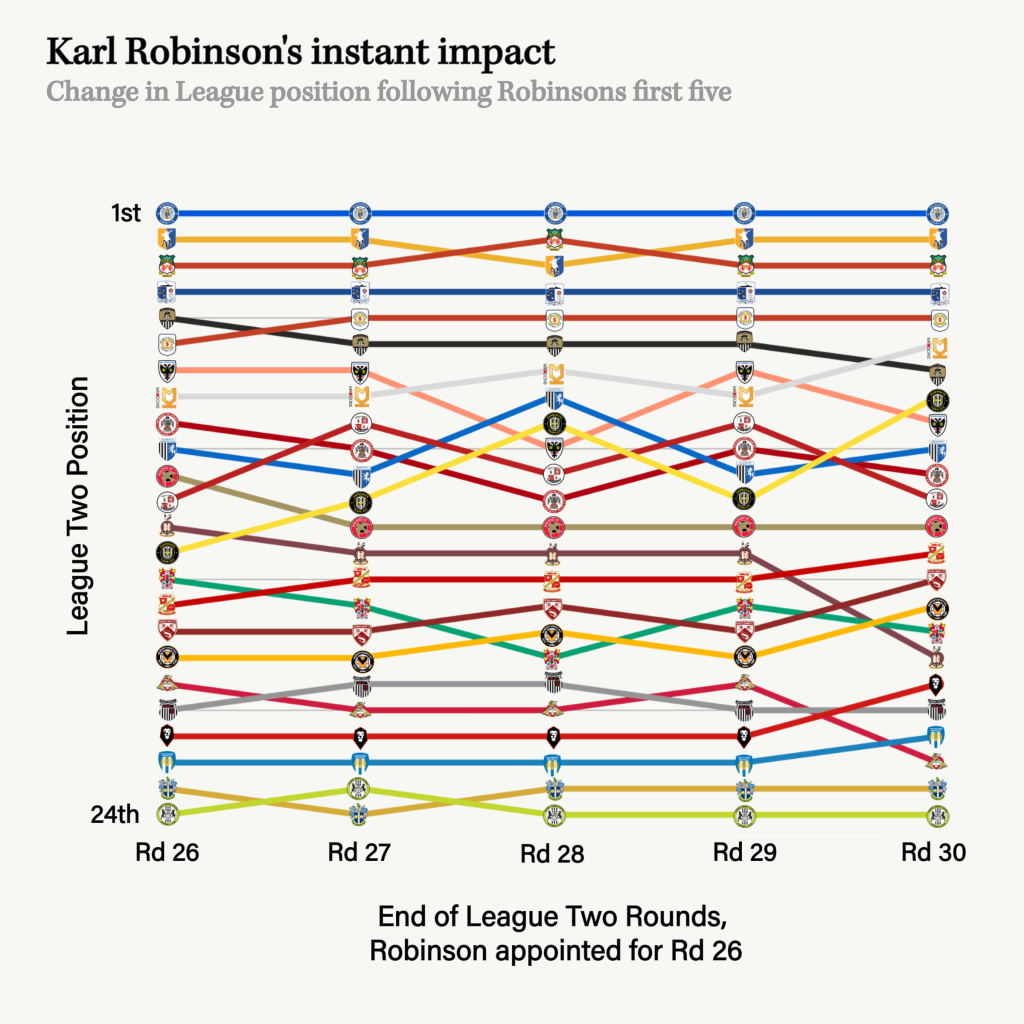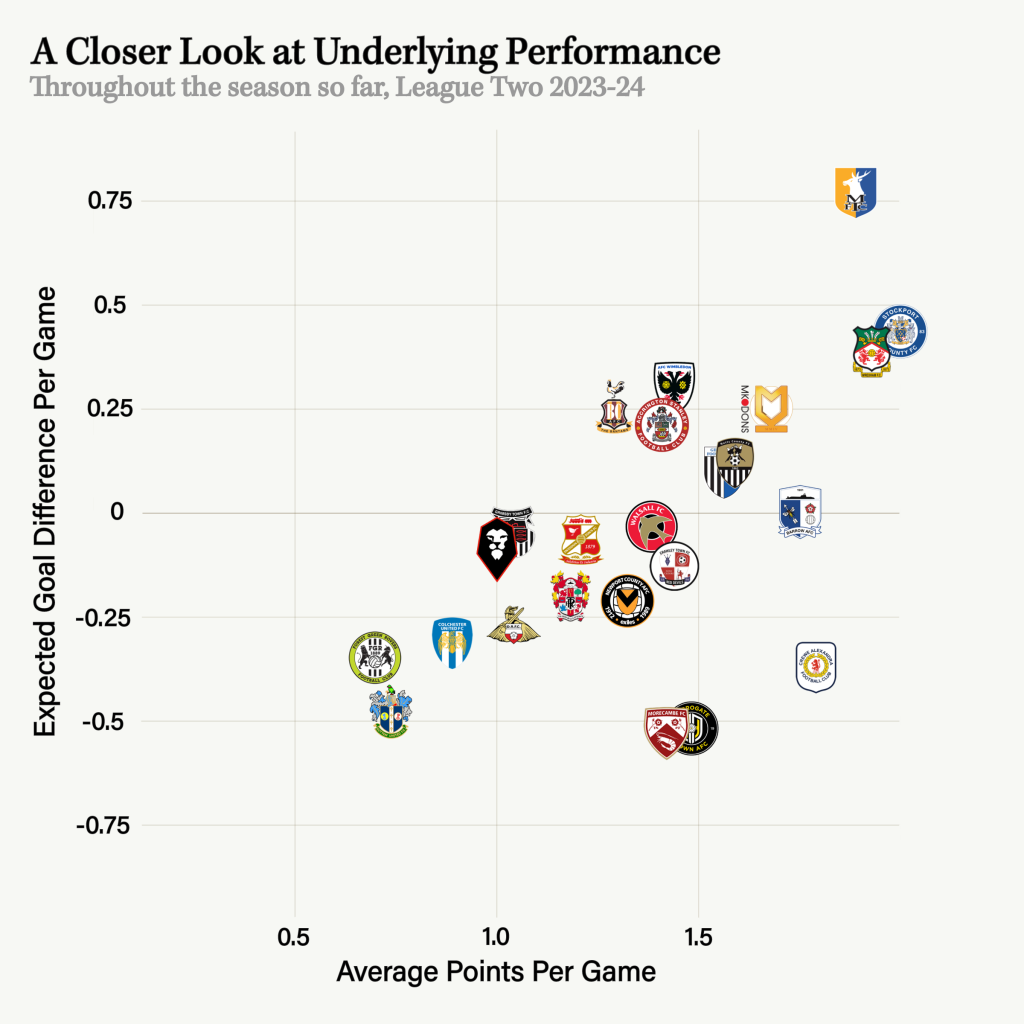
“All I’ve done is stood on the touchline,” Salford manager Karl Robinson addressed the Ammies’ shock turn-around this season.
Since his arrival at Salford City in January, head coach Karl Robinson has continued to downplay his role in the team’s dramatic change in form.
Brought in as a replacement to Neil Wood, Robinson inherited a side that had picked up just 2 points in their last seven League games.
In the aftermath of Salford’s 3–1 win against Wrexham, he noted: “I’ve just helped, it’s the players that take on information and work hard every day.”
Prior to the appointment of Robinson, The Ammies were beginning to sleepwalk into a relegation battle. With the team sitting five points off the drop zone and discontent growing, evasive action was taken as the club looked to spark a turnaround.

Yet even the most optimistic member of the club’s hierarchy would have struggled to forecast such a dramatic improvement.
The “frustration” fuelled side with “A point to Prove” have been revived in next to no time at all. The former Oxford United, Charlton and MK Dons boss highlighted that the players have a sense of “regret” and are intent on making amends for the poor run of form earlier in the campaign.
Back in the driver’s seat after a role as Assistant Manager to Sam Allardyce at Leeds United, Robinson now has six games under his belt and is yet to see his side lose.
In the impressive unbeaten spell, the transformed Ammies have “clawed” their way away from relegation rivals, quickly dispelling the growing concerns that a fall from the Football League could be on the horizon. Following a draw on the road against Swindon, Salford City have established a comfortable thirteen-point gap between them and 23rd-place Sutton United.
With Robinson saying: “The players know that they’ve been under-par (this season).”
Prior to Robinson’s arrival, the squad had failed to build an impressive 2022/23 season that culminated in a narrow penalty shootout loss against rivals Stockport County. Yet there were signs that Salford’s League position belied the true quality of the team.
Salford’s underlying performance levels, fortune and quality can be best analysed using the statistically sound metrics: Expected Goals and Expected Goal Difference.
The Expected Goals (xG) reading is a statistical measure which accounts for the quality of chances created by a side. The higher the number of big opportunities fashioned by a team in a game, the larger their xG value will be. Teams with the higher xG values per game, tend to convert their chances over the course of the season and therefore usually sit higher up the League Table.
Charting the Expected Goals per game of every side in League Two this season looks like this:
Charting Expected Goals by Edward Hayton
It’s hardly surprising that the team top of the League table leads the way in the xG charts. Stockport County are the division’s leading scorers and Dave Challinor’s men have found the back of the net in all but four of their League games this season.
Behind County in the chart, Mansfield and Wrexham are firmly in the promotion picture. It’s hard to argue with Robinson’s suggestion that the Welsh outfit are “One of the most resourced teams” in the division with “so many good players.” Therefore it’s no shock that Wrexham are in contention for a second successive promotion, the Red Dragons have continued to bring in players from clubs levels above the fourth tier of English football. They continue to ride the crest of their Hollywood takeover.
Remarkably, over the course of the season so far, Salford City have averaged nearly half an expected goal (0.46) more than 7th place Harrogate Town. Despite being 12 points worse off than Harrogate, Salford has consistently created better chances than the Yorkshire side throughout the season.
In fact, The Ammies have the 9th highest expected goals rating in the League, which indicates that the team have lacked a clinical edge to match their creativity.
After the game, top-scorer Matt Smith lamented his sides wastefulness in front of goal. “We just haven’t taken our chances so far this season and it has really cost us.”
However, he explained that the side feel re-energised under Robinson suggesting that “the goals will start to flow” as the team continues on an upward curve. “If we continue to play how we are playing under Karl, we will to create plenty of chances and carve out scoring opportunities regularly.”

“We’ve found a lovely balance at the moment” Robinson believes that “hard work” is the key to being competitive and “earning the respect” of the division’s best teams.
Salford City’s lack of form prior to Robinson’s signing on was exacerbated by a run of wretched defensive performances. The team may have been forming goal-scoring opportunities, but they were routinely offering up bigger chances to their rivals.
As illustrated in the graph above, throughout the season Salford have consistently allowed the opposition to manufacture better openings and have been subsequently punished.
However, The Ammies still have a far superior expected goal difference rating when compared with many of the teams in League Two’s bottom half.
Expected Goal difference is a measure that takes into account the effectiveness of a team on the attack and their ability to nullify the opposing side. It can be calculated by finding the difference between a club’s Expected Goal rating and the quantity of Expected Goals they concede to the other team.
But teams like Crewe and Morecambe continue to prove that the only stat that really matters is League points. As indicated in the chart, Crewe are dramatically outperforming their xGD. It would be too easy to predict that Crewe will fall away from their lofty League position.
How can they continue to concede so many big chances and keep winning? Surely they can’t ride their luck to promotion?
Whilst the underlying statistics might suggest that Crewe aren’t at the level of the teams around them, sometimes it can be hard to quantify the value of a last-ditch tackle, a miracle save or a wondergoal.
It’s arguable looking at the stats alone that Salford have been unfortunate throughout the season, perhaps their good form is to be expected.
Robinson is hopeful that with the application of the team will make their own luck and continue to build on recent performances, saying: “The football seasons are so difficult and so relentless, we’ve just got to find a way.”
Even though underlying metrics can help to visualise a team’s performance levels across the season, sometimes there is no substitute for the eye test.
Salford City look reborn under Robinson and there would be little surprise if the team continued to climb the most important ranking and finish the season closer to the summit of League Two.













Recent Comments